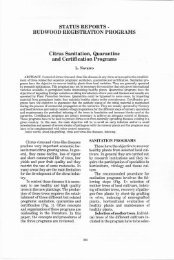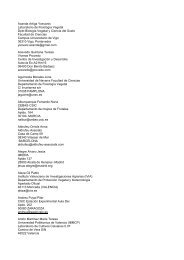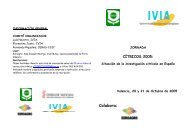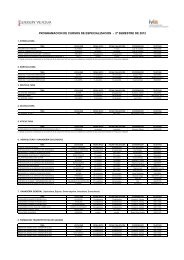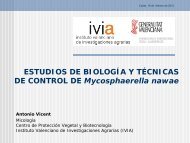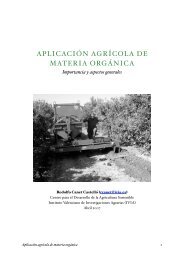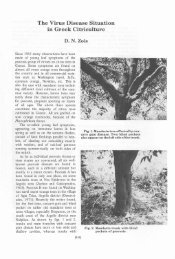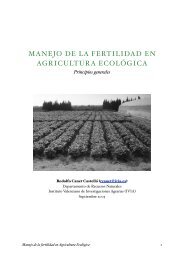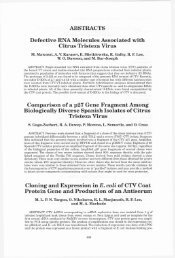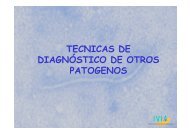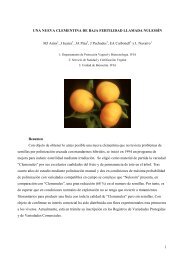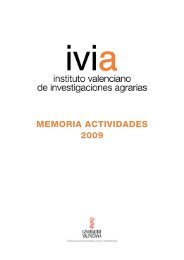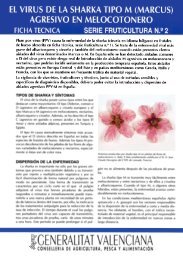Monique Garnier and J. M. Bové - IVIA
Monique Garnier and J. M. Bové - IVIA
Monique Garnier and J. M. Bové - IVIA
You also want an ePaper? Increase the reach of your titles
YUMPU automatically turns print PDFs into web optimized ePapers that Google loves.
Distribution of the Huanglongbing (Greening)<br />
Liberobacter Species in Fifteen African <strong>and</strong><br />
Asian Countries<br />
<strong>Monique</strong> <strong>Garnier</strong> <strong>and</strong> J. M. Bov6<br />
ABSTRACT. The distribution of the two Huanglongbing (greening) liberobacter species, Liberobacter<br />
asiaticum <strong>and</strong> Liberobacter africanum, was studied by DNA-DNA hybridization with<br />
probe In 2.6 which is specific for L. asiaticum <strong>and</strong> AS 1.7 which is specific for L. africanum, as well<br />
as by PCR followed by XbaI restriction of the amplified DNA. Only L. asiaticum was found in isolates<br />
from the 11 Asian countries studied (i.e., India, Nepal, Sri Lanka, Vietnam, Cambodia,<br />
Malaysia, Indonesia, Thail<strong>and</strong>, the Philippines, Taiwan <strong>and</strong> China). Only L. africanum was found<br />
in samples from South Africa <strong>and</strong> Zimbabwe. Both L. asiaticum <strong>and</strong> L. africanum were present in<br />
Reunion <strong>and</strong> Mauritius, sometimes in separate trees or even co-existing in the same trees. Citrus<br />
leaves from New Caledonia <strong>and</strong> Western Samoa, showing zinc deficiency symptoms or yellows,<br />
but not blotchy mottle, were found to be free of liberobacters.<br />
The microorganism responsible<br />
for citrus Huanglongbing (HLB)<br />
(Greening disease) was first<br />
observed by electron microscopy in<br />
1970 in the phloem sieve tubes of<br />
infected Eloff sweet orange trees<br />
from Nelspruit, South Africa (12).<br />
The organism was soon found to be a<br />
walled bacterium rather than a wallless<br />
mycoplasma (2,17). It has a filamentous<br />
morphology but shows<br />
polymorphism with great variations<br />
in the length <strong>and</strong> diameter of the filaments<br />
as well as round forms of the<br />
bacterium in the sieve tubes (5). The<br />
HLB bacterium, because of its typical<br />
gram-negative bacterial cell wall,<br />
is easily distinguished from other<br />
phloem-restricted prokaryotes, such<br />
as phytoplasmas <strong>and</strong> spiroplasmas,<br />
which lack a cell wall <strong>and</strong> are only<br />
surrounded by a cytoplasmic membrane<br />
(2,6,17). As of today, the HLB<br />
bacterium has resisted in vitro cultivation,<br />
but has been taxonomically<br />
characterized <strong>and</strong> shown to belong<br />
to the alpha subdivision of the proteobacteria<br />
(9). Two "C<strong>and</strong>idatus"<br />
species have been recognized: "C<strong>and</strong>idatus<br />
Liberobacter asiaticum" <strong>and</strong><br />
"C<strong>and</strong>idatus Liberobacter africanum"<br />
(9).<br />
Electron microscopy was the only<br />
technique for the detection of the<br />
HLB liberobacters until 1992. How-<br />
ever, with this technique, L. asiaticum<br />
<strong>and</strong> L. africanum could not be<br />
distinguished as they are morphologically<br />
identical.<br />
In 1992, a DNA probe (In 2.6)<br />
was obtained for the detection of L.<br />
asiaticum (18), <strong>and</strong> in 1995, a similar<br />
probe (AS 1.7) was produced for<br />
the detection of L. africanum (16).<br />
More recently, PCR has been developed<br />
for the detection <strong>and</strong> identification<br />
of the two species (8, 10). This<br />
paper presents the results of a study<br />
of the liberobacter species present in<br />
15 countries in Asia <strong>and</strong> Africa.<br />
HLB liberobacters have been<br />
observed by electron microscopy in<br />
the phloem sieve tubes of leaf midribs<br />
or fruit axes of infected citrus<br />
trees collected in 13 Asian <strong>and</strong> eight<br />
African countries, as well as in<br />
Saudi Arabia <strong>and</strong> Yemen (3) <strong>and</strong> in<br />
Mauritius <strong>and</strong> Reunion Isl<strong>and</strong>s in<br />
the Indian Ocean (Tables 1 <strong>and</strong> 2).<br />
These numerous observations have<br />
shown that the liberobacters are<br />
restricted to the phloem sap in<br />
which they are introduced by their<br />
psyllid vectors; they are never<br />
observed within phloem parenchyma<br />
cells nor in the cytoplasm of phloem<br />
tissue.<br />
HLB-infected leaf samples from<br />
trees sampled in 18 different countries<br />
were analyzed by DNAIDNA
Thirteenth ZOCV Conference, 1996- Short Communications 389<br />
TABLE 1<br />
OCCURRENCE OF LIBEROBACTER ASIATICUM AND/OR LIBEROBACTER AFRICANUM IN<br />
VARIOUS COUNTRIES<br />
Presence oP<br />
No. of samples<br />
Country L. asiaticum L. africanum EM tested<br />
India<br />
Nepal<br />
Sri Lanka<br />
Vietnam<br />
Cambodia<br />
Malaysia<br />
Indonesia<br />
Thail<strong>and</strong><br />
Philippines<br />
Taiwan<br />
China<br />
South Africa<br />
Zimbabwe<br />
Reunion<br />
Mauritius<br />
New Caledonia<br />
Western Samoa<br />
Martinique<br />
zDetermined by hybridization <strong>and</strong>lor PCR<br />
hybridization with probes In 2.6 <strong>and</strong><br />
AS 1.7 <strong>and</strong>lor by PCR to determine<br />
the Liberobacter species present (8,<br />
10). Results are indicated in Table 1.<br />
In Asia, where more than 300 samples<br />
from 11 countries* were analyzed,<br />
only L. asiaticum was<br />
detected, <strong>and</strong> in Africa only L. africanum<br />
was present on the basis of<br />
83 samples from South Africa <strong>and</strong><br />
Zimbabwe. In Reunion <strong>and</strong> Mauritius,<br />
both liberobacter species were<br />
detected by DNA/DNA hybridization<br />
<strong>and</strong> PCR. The two species were generally<br />
present in different trees, but<br />
some trees were infected with both<br />
(7). Finally, the HLB liberobacter<br />
could not be detected in samples<br />
TABLE 2<br />
OCCURRENCE OF LIBEROBACTER IN ADDITIONAL COUNTRIES AS DETERMINED BY<br />
ELECTRON MICROSCOPY<br />
COUNTRY<br />
Japan<br />
Bangladesh<br />
Pakistan<br />
Saudi Arabia<br />
Yemen<br />
Burundi<br />
Cameroun<br />
Kenya<br />
Malawi<br />
Rw<strong>and</strong>a<br />
Somalia<br />
REFERENCE<br />
Miyakawa <strong>and</strong> Tsuno (15)<br />
Catling et al. (4)<br />
<strong>Garnier</strong> <strong>and</strong> Bod, unpublished<br />
Bov6 <strong>and</strong> <strong>Garnier</strong> (3)<br />
Bov6 <strong>and</strong> <strong>Garnier</strong> (3)<br />
Aubert et al. (1)<br />
Aubert et al. (1)<br />
<strong>Garnier</strong> <strong>and</strong> Bov6, unpublished<br />
Aubert et al. (1)<br />
Aubert et al. (1)<br />
<strong>Garnier</strong> <strong>and</strong> Bov6, unpublished
390 Thirteenth IOCV Conference, 1996-Short Communications<br />
from New Caledonia, Western<br />
Samoa <strong>and</strong> Martinique, where the<br />
presence of the HLB liberobacter<br />
was questioned on the basis of some<br />
branch yellowing symptoms, even<br />
though the two psyllid vectors of<br />
HLB are known to be absent.<br />
In conclusion, PCR or DNA/DNA<br />
hybridization techniques can be<br />
used to detect the two HLB liberobacter<br />
species. In Asia, only L. asiaticum,<br />
vectored by the psyllid<br />
Diaphorina citri Kuwayama, was<br />
present. In Africa, samples from the<br />
two countries examined (South<br />
Africa <strong>and</strong> Zimbabwe), were found to<br />
contain only L. africanum, vectored<br />
by the African psyllid, Trioza<br />
erytreae (Del Guercio). In Reunion<br />
<strong>and</strong> Mauritius, where both psyllicls<br />
are present, both liberobacter species<br />
have been found, in separate as<br />
well as a few dually infected trees.<br />
Whether the two psyllids are able in<br />
nature, to transmit both liberobacter<br />
species, as was demonstrated experimentally<br />
(13, 14), remains to be<br />
determined.<br />
Citrus is known to have originated<br />
from Asia <strong>and</strong> it is generally<br />
thought that most of their pathogens<br />
also have an Asian origin. The<br />
results described above suggest that<br />
L. africanum was not introduced<br />
from Asia into Africa with citrus.<br />
Thus, Liberobacter species are<br />
either insect-borne pathogens, or<br />
were acquired by the respective psyllids<br />
from indigenous rutaceous<br />
plants. Indeed, in Africa we have<br />
shown that Toddalia lanceolata, an<br />
indigenous rutaceous species, is a<br />
good host of both T. erytreae <strong>and</strong> L.<br />
africanum (11).<br />
"Note: HLB-affected citrus trees<br />
have now also been found by us in<br />
Burma <strong>and</strong> Laos, <strong>and</strong> the agent is L.<br />
asiaticum.<br />
LITERATURE CITED<br />
1. Aubert, B., M. <strong>Garnier</strong>, J. C. Cassin, <strong>and</strong> Y. Bertin<br />
1988. Citrus greening disease survey in East <strong>and</strong> West African countries South of<br />
Sahara, p. 231-237. In: Proc. 10th Conf. IOCV., IOCV, Riverside.<br />
2. Bove, J. M. <strong>and</strong> P. Saglio<br />
1974. Stubborn <strong>and</strong> Greening: A review, 1969-1972, p. 1-11 In: Proc. 6th Conf. IOCV.,<br />
IOCV, Riverside.<br />
3. Bov6, J. M. <strong>and</strong> M. <strong>Garnier</strong><br />
1984. Citrus greening <strong>and</strong> psylla vectors of the disease in the Arabian Peninsula, p. 109-<br />
114. In: Proc. 9th Conf. IOCV., IOCV, Riverside.<br />
4. Catling, H. D., M. <strong>Garnier</strong>, <strong>and</strong> J. M. Bove<br />
1978. Presence of citrus greening disease in Bangladesh <strong>and</strong> a new method for rapid<br />
diagnosis. FA0 Plant Prot. Bull. 26: 16-18.<br />
5. <strong>Garnier</strong>, M. <strong>and</strong> J. M. Bov6<br />
1983. Transmission of the organism associated with citrus greening disease from sweet<br />
orange to periwinkle by dodder. Phytopathology 73: 1358-1363.<br />
6. <strong>Garnier</strong>, M., N. Danel, <strong>and</strong> J. M. Bov6<br />
1984. The greening organism is a gram negative bacterium, p. 115-124. In: Proc. 9th<br />
Conf. IOCV., IOCV, Riverside.<br />
7. <strong>Garnier</strong>, M., S. Jagoueix, P. Toorawa, M. Grisoni, R. Mallessard, A. Dookun, S. Saumtally, J.<br />
C. Autrey, <strong>and</strong> J. M. Bov6<br />
1996. Both Huanglongbing (greening) Liberobacter species are present in Mauritius <strong>and</strong><br />
Reunion, p. 392-394. In: Proc. 13th Conf. IOCV., IOCV, Riverside.<br />
8. Jagoueix, S., J. M. Bove, <strong>and</strong> M. <strong>Garnier</strong><br />
1996. Techniques for the specific detection of the two Huanglongbing (greening) liberobacter<br />
species: DNA/DNA hybridization <strong>and</strong> DNA amplification by PCR, p. 384-387. In:<br />
Proc. 13th Conf. IOCV., IOCV, Riverside.<br />
9. Jagoueix, S., J. M. Bove, <strong>and</strong> M. <strong>Garnier</strong><br />
1994. The phloem-limited bacterium of greening disease of citrus is a member of the a-<br />
subdivision of the proteobacteria. J. Intern. Syst. Bacterial. 44: 397-386.<br />
10. Jagoueix, S., J. M. Bod, <strong>and</strong> M. <strong>Garnier</strong><br />
1996. PCR detection of the two liberobacter species associated with greening disease of<br />
citrus. Mol. Cell. Probes 10: 43-50.
Thirteenth ZOCV Conference, 1996-Short Communications 391<br />
Korsten, L., S. Jagoueix, J. M. Bov6, <strong>and</strong> M. <strong>Garnier</strong><br />
1996. Huanglongbing (greening) detection in South Africa, p. 395-398. In: Proc. 13th<br />
Conf. IOCV., IOCV, Riverside.<br />
LaflBche, D. <strong>and</strong> J. M. Bov6<br />
1970. Structures de type mycoplasme dans les feuilles d'orangers atteints de la maladie<br />
du "greening". C. R. Acad. Sci. Paris Ser. D 270: 1915-1917.<br />
Lallem<strong>and</strong>, J., A. Fos, <strong>and</strong> J. M. Bov6<br />
1986. Transmission de la bact6rie associ6e a la forme africaine de la maladie du "greening"<br />
par le psylle asiatique Diaphorina citri Kuwayama. Fruits 41: 341- 343.<br />
Massonib, G., M. <strong>Garnier</strong>, <strong>and</strong> J. M. Bov6<br />
1976. Transmission of Indian citrus decline by Trioza erytreae (Del G.), the vector of<br />
South African greening, p. 18-20. In: Proc. 7th Conf. IOCV. IOCV, Riverside.<br />
Miyakawa, T. <strong>and</strong> K. Tsuno<br />
1989. Occurrence of citrus greening in the southern isl<strong>and</strong>s of Japan. Ann. Phytopathol.<br />
Soc. Japan 66: 667-670.<br />
Planet, P., S. Jagoueix, J. M. Bov6, <strong>and</strong> M. <strong>Garnier</strong><br />
1995. Detection <strong>and</strong> characterization of the African citrus greening liberobacter by<br />
amplification, cloning <strong>and</strong> sequencing of the rplKAJL-rpoBC operon. Curr. Microbiol.<br />
30: 137-141.<br />
Saglio, P., D. LaflBche, C. Bonissol, <strong>and</strong> J. M. Bov6<br />
1971. Isolement, culture et observation au microscope Blectronique des structures de<br />
type mycoplasme associ6es a la maladie du stubborn des agrumes et leur comparaison<br />
avec les structures observ6es dans le cas de la maladie du greening des agrumes. Physiol.<br />
V6g. 9: 569-582.<br />
Villechanoux, S., M. <strong>Garnier</strong>, J. Renaudin, <strong>and</strong> J. M. Bov6<br />
1992. Detection of several strains of the bacterium-like organism of citrus greening disease<br />
by DNA probes. Curr. Microbiol. 24: 89-95.



